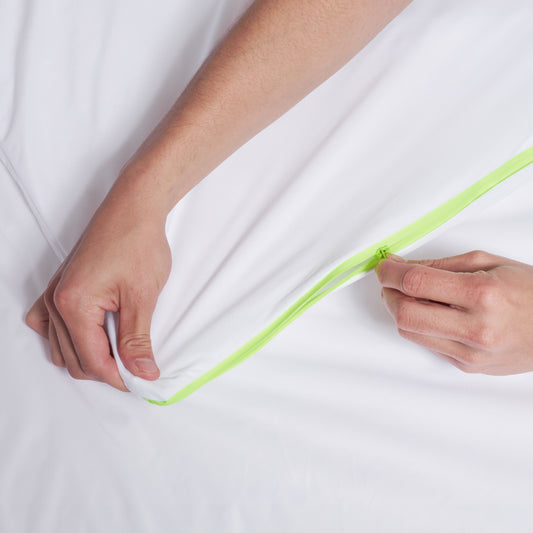Anti Allergy Bedding Does It Work?
To answer if anti allergy bedding works, we need to look at what protectors / encasements do to your bed.
A dust mite protector is a cover designed to encase mattresses, pillows, and duvets to prevent dust mites and their allergens from coming into contact with the person using them.
They are normally made from tightly woven fabric or materials that are impermeable to dust mites and their waste products. They are often zippered, ensuring that the entire bedding item is enclosed and protected.

Its primary purpose is to stop reinfestation of your Mattress / Pillow and Duvet.
- Dust mites are trapped inside encasement and die due to no food
- Dust mites on the surface cannot hide inside mattress / pillow / duvet
- The dust mites on the surface will die when you wash your bedding at 60 degrees
How Dust Mite Encasements / Protectors / Bedding Work
After 1 Hour:
- Without Protector: Dust mites in the pillowcase have not yet had enough time to migrate onto the pillowcase itself.
- With Protector: There is no discernible difference observed between using a protector and not using one.
After 24 Hours:
- Without Protector: Dust mites have moved from inside the pillow to the pillowcase and have begun laying eggs.
- With Protector: Dust mites remain trapped inside the pillow and cannot reach the pillowcase. However, about 50 dust mites have landed on the cover, either blown from surrounding furniture or items, or have climbed from the bed, divan, or pajamas.
After 7 Days:
- Without Protector: A greater number of dust mites have migrated from the pillow to the pillowcase. The increased space and food supply support the growth of the dust mite population, with eggs starting to hatch within 6 to 12 days.
- With Protector: Dust mites inside the pillow begin to die from lack of access to food. Meanwhile, the small number of dust mites that transferred onto the cover from elsewhere have increased in population as their eggs have started to hatch.
This scenario assumes that the bedsheets have been recently washed at 60 degrees Celsius or have been frozen for 7 days.
Importance of Dust Mite Encasements
Using covers will result in a large reduction of dust mites. Although no research has been able to directly indicate how exactly many dust mites die from using covers due to the difficulty in measuring them, we can presume this example to be accurate due to the studies showing a reduction in the amount of dust mites per a gram and reduced dust mite allergy symptoms.
The example also illustrates the importance of stopping reinfestation from other sources in the room. A dust mite proof bed will not remain dust mite free for long due to dust mites spreading from other areas and their ability to reproduce fast. This is why dust mite bedding should not be the only solution to getting rid of your dust mite allergy.
Key Features for The Best Dust Mite Allergy Bedding
When selecting a dust mite protector, ensure it includes the following features:
- Dust Mite-Proof Zipper and Fabric: Make sure both the zipper and the fabric are designed to prevent dust mites from entering or exiting. Some products only offer dust mite-proof fabric, so check both components.
- Comfortable Design: A comfortable night's sleep is crucial for your health. Many dust mite allergy beddings can feel plasticky, so consider options made from Eucalyptus or Bamboo materials, which are ultra-soft.
- Breathability: Since dust mites thrive in humidity, choose encasements that allow moisture to escape. This will help reduce your dust mite allergy symptoms.
- Freezer-Safe or Washable at 60 Degrees: It is essential to eliminate dust mites monthly from your encasements. You can do this by either freezing them or washing them at 60 degrees Celsius. Freezing tends to preserve the encasements better than frequent washing.
Click here to view our recommended protectors
For more information on how to get rid of dust mites in 6 steps, check out our guide here
Sign up for discount and Step 6 of How To Get Rid of Dust Mites
Anti Dust Mite Bedding
-
Anti Dust Mite Allergy Protector | Mattress + Pillow + Duvet Bundle
Regular price From £139.99 GBPRegular priceUnit price / per£239.99 GBPSale price From £139.99 GBPSale -
Dust Mite Mattress Protector | Allergy Mattress Cover
Regular price From £59.99 GBPRegular priceUnit price / per -
Dust Mite Pillow Covers | Allergy Pillow Cases
Regular price £39.99 GBPRegular priceUnit price / per -
Dust Mite Duvet Encasement | Allergy Duvet Protector
Regular price From £89.99 GBPRegular priceUnit price / per£139.99 GBPSale price From £89.99 GBPSale
Anti Dust Mite Tools
-
Best Dehumidifier for Dust Mite Allergy
Regular price £104.99 GBPRegular priceUnit price / per£139.99 GBPSale price £104.99 GBPSale -
Dust Air Purifier | HEPA Filter for Dust Mite Allergy
Regular price £169.99 GBPRegular priceUnit price / per -
Dust Mite Killer Spray | Eucalyptus Oil
Regular price From £14.99 GBPRegular priceUnit price / per -
Hepa Dust Mite Vacuum Cleaner - Best for Dust Mite Allergy
Regular price From £7.99 GBPRegular priceUnit price / per









